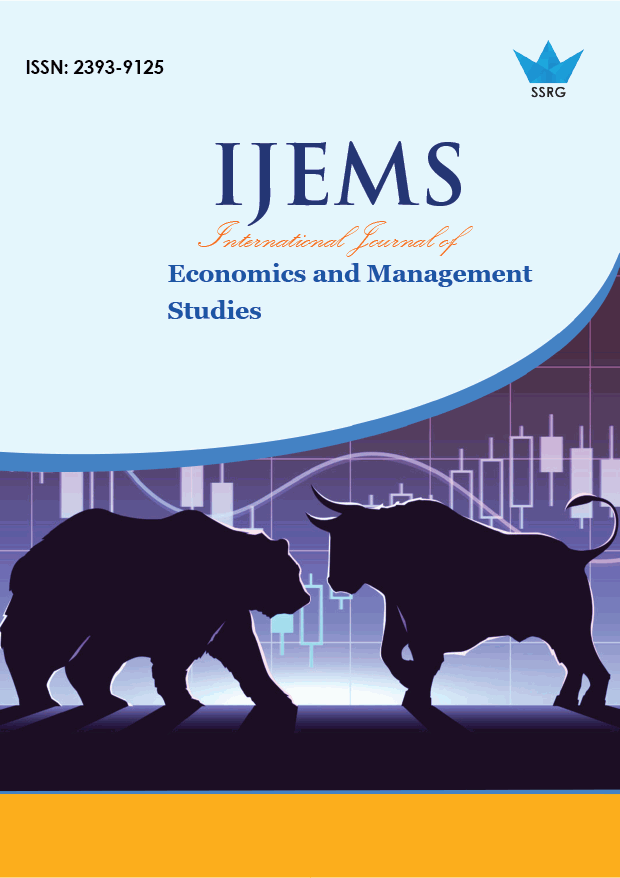The Effect Of Intellectual Capital And Potential Absorptive Capacity To The Realized Absoptive Capacity Of Tourism Service Industry

| International Journal of Economics and Management Studies |
| © 2019 by SSRG - IJEMS Journal |
| Volume 6 Issue 5 |
| Year of Publication : 2019 |
| Authors : Wisnu Yuwono , Dadan Umar Daihani , Willy Arafah |
How to Cite?
Wisnu Yuwono , Dadan Umar Daihani , Willy Arafah, "The Effect Of Intellectual Capital And Potential Absorptive Capacity To The Realized Absoptive Capacity Of Tourism Service Industry," SSRG International Journal of Economics and Management Studies, vol. 6, no. 5, pp. 96-101, 2019. Crossref, https://doi.org/10.14445/23939125/IJEMS-V6I5P115
Abstract:
The purpose of this study is to examine the effect of intellectual capital and potential absorptive capacity to the realized absorptive capacity of the tourism service industry in Batam City, Riau Islands Province, Indonesia. The concept of realized absorptive capacity has become an important issue for the development of industry, whereby the relevant knowledge of the organizations, they can develop further knowledge into useful knowledge for increasing creativity. The involved respondents of this study are amount to 54 CEOs (Chief Executive Officers) who manage a travel business. Data were analyzed by Structural Equation Model (SEM) by using the 3.0 version of SmartPLS software. The results showed that the intellectual capital had an effect of potential absorptive capacity, intellectual capital had an effect of realized absorptive capacity, potential absorptive capacity had no effect of realized absorptive capacity, and potential absorptive capacity did not mediate the relationship of both intellectual capital and the realized absorptive capacity
Keywords:
intellectual capital, potential absorptive capacity, realized absorptive capacity.
References:
[1] Albort-Morant, G., Leal-Rodríguez, A. L., & Marchi, V. De. (2018). Absorptive capacity and relationship learning mechanisms as complementary drivers of green innovation performance. Journal of Knowledge Management, 0(0), 1–21. http://doi.org/10.1108/JKM-07-2017-0310
[2] ASEAN. (2017). Tourist Arrivals in ASEAN. Retrieved from http://asean.org/storage/2015/09/Table-28-checked.pdf
[3] Cassol, A., Gonçalo, C. R., & Ruas, R. L. (2016). Redefining the relationship between intellectual capital and innovation : The mediating role of absorptive capacity. Brazilian Administration Review, 13(4), 1–25. http://doi.org/10.1590/1807-7692bar2016150067
[4] Cettin, S., & Fidan, Y. (2017). The Relationship Among Human Capital Absortive Capacity and Innovation Performance. Business & Management Studies: An International Journal, 5(4), 1–22. http://doi.org/10.15295/bmij.v5i4.139 İNSAN
[5] Cohen, W. M., & Levinthal, D. A. (2012). Absorptive Capacity : A New Perspective on and Innovation Learning. Administrative Science Quarterly, 35(1), 128–152. Retrieved from http://www.jstor.org/stable/2393553
[6] Costa, R. V., Fernandez, C. F.-J., & P. Dorrego, F. (2014). Critical elements for product innovation at Portuguese innovative SMEs : an intellectual capital perspective. Knowledge Management Research & Practice, 12(3), 322–338. http://doi.org/10.1057/kmrp.2014.15
[7] Davila, G. A., Durst, S., & Varvakis, G. (2018). Knowledge Absorptive Capacity, Innovation, and Firm’s Performance Performance: Insights From The South of Brazil. International Journal of Innovation Management, 22(2), 1–34. http://doi.org/10.1142/S1363919618500135
[8] Engelman, R. M., Fracasso, E. M., Schmidt, S., & Zen, A. C. (2017). Intellectual capital, absorptive capacity and product innovation. Management Decision, 55(3), 474–490. http://doi.org/10.1108/MD-05-2016-0315
[9] Ghozali, I., & Latan, H. (2013). Partial Least Squares: Konsep, teknik dan Aplikasi Menggunakan program SmartPLS 3.0. Badan Penerbit Universitas Diponegoro Semarang.
[10] Gunawan, W., Gerardus, P., Tji, B. J., & Richard, K. (2017). The Use of Absorptive Capacity in Improving the New Product Development (NPD). In International Conference on Computing and Applied Informatics 2016 (pp. 1–10). http://doi.org/10.1088/1742-6596/755/1/011001
[11] Hernandez-Perlines, F. (2018). Moderating effect of absorptive capacity on the entrepreneurial orientation of international performance of family businesses. Journal of Family Business Management. http://doi.org/10.1108/JFBM-10-2017-0035
[12] Kaur, V., & Mehta, V. (2017). Dynamic Capabilities for Competitive Advantage : A Comparative Study of IT Multinationals in India. Paradigm, 21(1), 1–21. http://doi.org/10.1177/0971890717701781
[13] Leal-Rodríguez, A. L., Roldán, J. L., Ariza-Montes, J. A., & Leal-Millán, A. (2014). From potential absorptive capacity to innovation outcomes in project teams: The conditional mediating role of the realized absorptive capacity in a relational learning context. International Journal of Project Management, xx(xx). http://doi.org/10.1016/j.ijproman.2014.01.005
[14] Limaj, E., & Bernroider, E. (2017). The roles of absorptive capacity and cultural balance for exploratory and exploitative innovation in SMEs. Journal of Business Research Journal, xx(xx). http://doi.org/10.1016/j.jbusres.2017.10.052
[15] Mennens, K., Gils, A. Van, Odekerken-Schröder, G., & Letterie, W. (2018). Exploring antecedents of service innovation performance in manufacturing SMEs. International Small Business Journal: Researching Entrepreneurship, 00(0), 1–21. http://doi.org/10.1177/0266242617749687
[16] Nazarpoori, A. H. (2017). Survey the effects of intellectual capital and absorptive capacity on innovation capability (Case Study of Saipa Company in Tehran). International Journal of Innovation Management, 21(2), 1–19. http://doi.org/10.1142/S1363919617500293
[17] Ratnasari, S. L. (2017). Aktualisasi peran pemimpin nasional dalam pengembangan sumber daya manusia bidang pariwisata. Dimensi, 6(3), 464–474.
[18] Rizki, S. (2014). Strategi Dinas Pariwisata Dan Kebudayaan Kota Batam Dalam Mengembangkan Kota Batam Sebagai Destinasi Wisata Mice (Meeting, Intencive, Conference And Exhibition) Tahun 2011-2014. JOM FISIP, 3(2), 1–13.
[19] Soo, C., Tian, A. W., Teo, S. T. T., & Cordery, J. (2017). Intellectual Capital-Enhancing HR, Absorptive Capacity, and Innovation, 56(3), 431–454. http://doi.org/DOI:10.1002/hrm.21783
[20] WTCC. (2017). Travel & Tourism Economic Impact 2017 World.
[21] Yao, F. K., & Chang, S. (2017). Do Individual Employees’ Learning Goal Orientation and Civic Virtue Matter? A Micro- Foundations Perspective on Firm Absorptive Capacity : The Micro-Foundations of Firm Absorptive Capacity. Strategic Management Journal, 38(10). http://doi.org/10.1002/jsfa.2636
[22] Yuwono, W. (2018). Perancangan model framework manajemen strategik planning sektor pariwisata di Provinsi Kepulauan Riau. Journal of Accounting & Management Innovation, 2(1), 14–25. Retrieved from https://ejournal.medan.uph.edu/index.php/jam/article/view/169/51
[23] Zahra, S. A., & George, G. (2002). ABSORPTIVE CAPACITY : A REVIEW , AND EXTENSION. Academy of Management, 27(2), 185–203. Retrieved from http://www.jstor.org/stable/4134351

 10.14445/23939125/IJEMS-V6I5P115
10.14445/23939125/IJEMS-V6I5P115